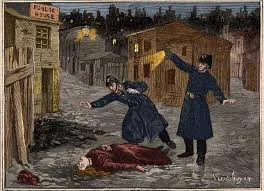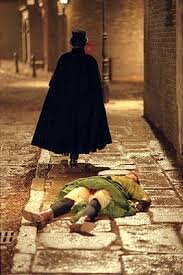Alas. The ‘Jack the Ripper’ Case Has Finally Been Solved. (Apparently)
Here in the tropics, the heat sometimes induces chronic inertia forcing one to take an extended siesta most afternoons. During my time here I have followed this practice religiously and justify this ritual by trying to read something before somnambulistic pleasures engulf me.
Now, my readings cover a wide and varied spectrum and recently I came across an excellent article by Guy Walters published in 2014 which comprehensively proved the identity of the notorious serial killer, Jack The Ripper.
The gist of the article conclusively proves that after 125 years the Jack the Ripper mystery may finally be solved. Alas.
My initial reaction was “Oh yeah” who is it now? Jane Austen, Lord Gladstone or maybe it was Queen Victoria herself. This is not so far fetched as over the years the list of suspects has included the names of eminent figures of that time such as Prince Albert Victor, the Duke of Clarence, and even Lewis Carroll was vaguely linked to the grisly crimes.
I devoured the article, determined to see just who would be revealed as the notorious killer. The more I read, it became apparent that this wasn’t some outlandish claim put forward by a Ripper enthusiast but a more than credible conclusion to what was the crime of the century. In fact, the entire process identifying the killer all came down to the science of DNA.
The story goes something like this:
In 2007, Russell Edwards, a London based businessman bought a shawl at a rather macabre auction that was said to belong to Catherine Eddowes, one of the Ripper's victims. Mr Edwards then travelled to Liverpool shawl in hand, to meet with Dr Jari Louhelainen, a senior lecturer in molecular biology at John Moores Institute.
Dr Louhelainen is one of the world’s leading specialist in genetics and forensic medicine so pretty qualified as an expert when it comes to examining a one hundred and twenty- five -year old garment for any traces of DNA.
Using a process called "vacuuming", the good doctor was able to extract enough DNA from bloodstains on the shawl to match the DNA taken from one of Eddowes's descendants. During the process of ‘Hoovering’ up any lingering stains on the fabric, Dr Louhelainen discovered minute traces of seminal fluid and that is where he was able to extract the DNA sequence he was searching for.
That tiny spec proved to be a 100 per cent match for a female descendant of the sister of one of the early Ripper suspects - a Polish-born hairdresser called Aaron Kosminski. This nondescript hairstylist turned out to be a man who regularly suffered from paranoid schizophrenia and wild hallucinations. His illness eventually led him to be committed to some dreadful asylum in 1891 until he died some twenty –eight years later in 1919.
Thus, if we are to assume that modern science is accurate and that Dr Louhelainen’s conclusions are correct then the mystery of just who the Ripper was, has been solved.
I hate to say this, but I am a tad disappointed with Kosminski being the chief suspect as it is boringly plausible. The mere idea that Jack the Ripper was a deranged madman, who was suspected by the police as being the culprit rings true but is perhaps rather dull. Even though the forensic evidence seems to overwhelmingly prove that Kosminski had to be the killer, I secretly never really wanted the case to end.
Truth be told if the authorities had followed the lead investigator Chief Inspector Donald Swanson’s iron-clad theory that Kosminski was the Ripper, he would have been apprehended and probably executed before the century was out.
This monumental finding will no doubt be devastating news to the legions of “Ripperologists” who will, in all probability debunk the theory and strive to keep the case alive. This dedicated band of macabre sleuths will now have nothing left to solve. There will be no new leads to follow, no further evidence to dissect and this will mean their lives will become empty, devoid of purpose and altogether worthless.
There is no doubt that there will be outcries enraged by the findings and we will no doubt read in future Jack the Ripper forums lengthy and peevish articles debunking Dr Louhelainen’s theory.
I am a little surprised that we haven’t yet head from the crime writer Patricia Cornwell, the queen of ‘Ripperology’ who will probably treat the good doctor's theory as absolute twaddle.
In 2002, our esteemed crime mistress published a book in which she confidently identified the well-known artist, Walter Sickert as being the dastardly serial killer. Her rather implausible deductions were based on the fact that the poses of some of the women in his paintings are similar to how the Ripper left his unfortunate victims.
Her rather flimsy assertions that Mr Sickert was the culprit was of course embraced by her fans, many of whom were die-hard “Ripperologists’.
I firmly believe that Ms Cornwell's problem is that she wanted Jack the Ripper to be someone of ‘substance. Someone remarkable. She, like millions like her, cannot conceive of the notion that such unsolved, sensationalised murders were committed by an obscure maniac and a hairdresser to boot are simply not satisfying.
A nondescript character such as Kosminski simply does not have sufficient gravitas to carry the role of one of the most notorious killers of all time. He would never have had the charisma to carry a plethora of books, films, documentaries and TV shows that have been built around his terrible crimes.
Subconsciously, we all treat horrible, true crimes as extensions of the entertainment industry. Works of fiction over the last century portrayed Jack the Ripper as a person of substance and therefore it is a bit of a shock to now discover that the murderer was a mere person who made his living cutting hair.
The general public love a mystery for its something to be discussed at dinner parties or around the water cooler in the office. Solved mysteries just don’t carry the same weight.
If Chief Inspector Swanson had arrested and charged Kosminski in 1888, then the case of "Jack the Ripper" would have slipped into obscurity. There were no shortages of serial killers in the 19th century yet nobody can recall the names of say Dr William Palmer a skilled poisoner who did away with several of his patients. Or take Sarah Freeman, who cold-bloodedly killed at least nine men, including her own brother.
However painful it is, we must learn to accept modern science and put imagination aside lest it triumphs over the facts. Personally I don’t find it very satisfying at all and, If Dr Louhelainen's meticulous findings are one day found to be flawed, then I for one will be delighted as I love a good mystery.
The story will then be resurrected to liven up a particularly boring dinner party.














